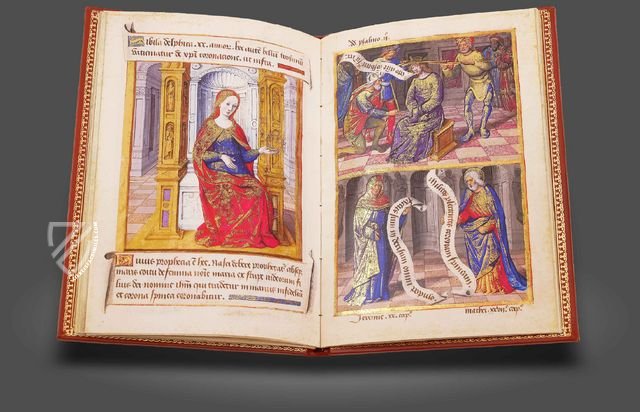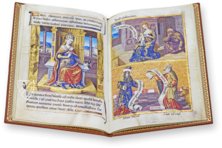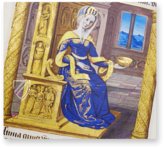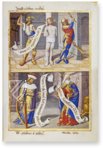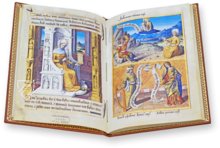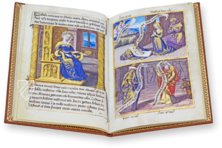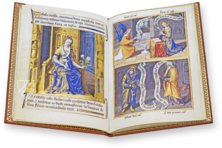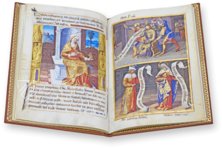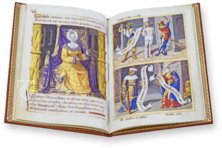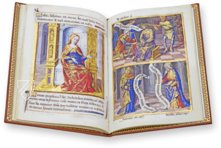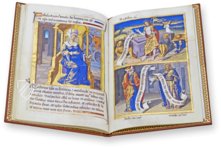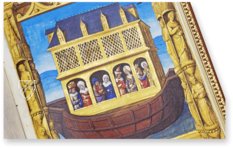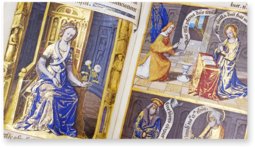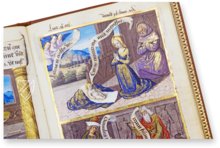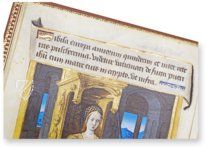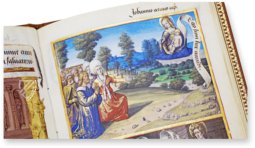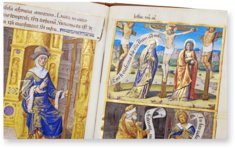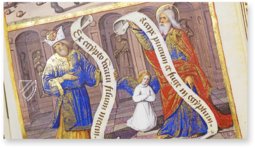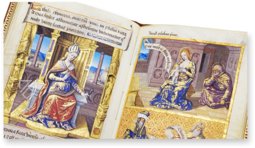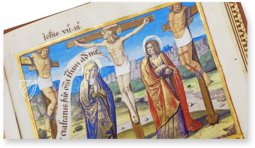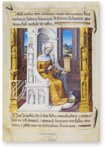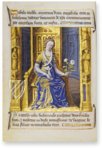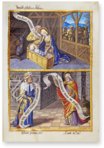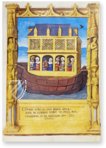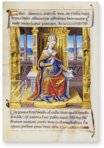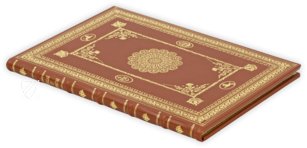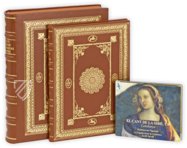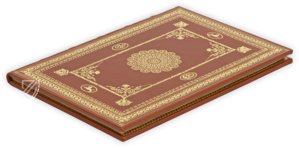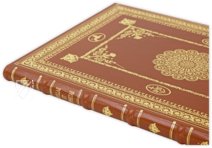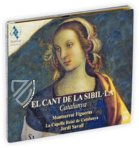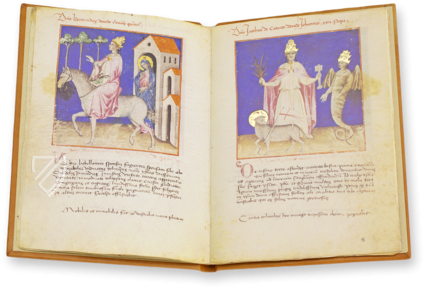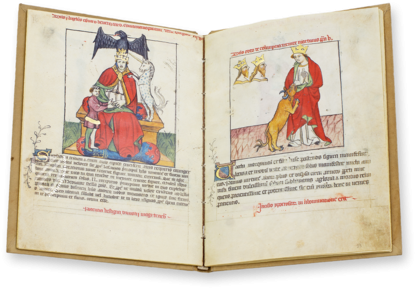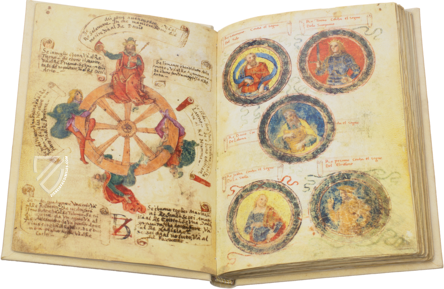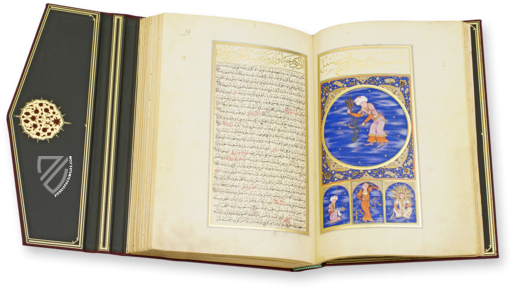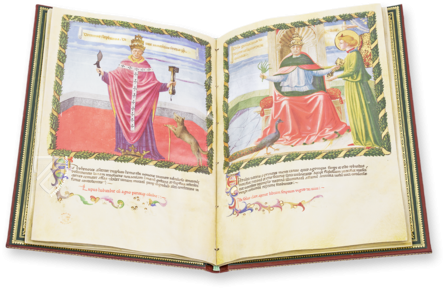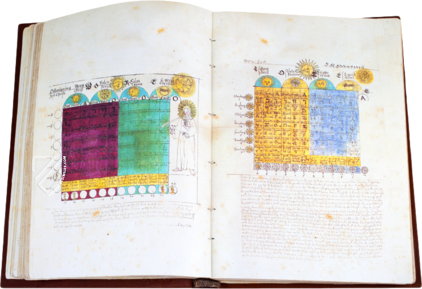Sibylline Prophecies
(3,000€ - 7,000€)
The Codex icon. 414 of the Bavarian State Library in Munich is a gorgeous late–15th century manuscript from the famous studio of Jean Poyer in Tours. In 25 impressive, large-format miniatures, the life story of Jesus is connected with the prophecies of the 12 Sibyls, and at the same time, the 12 prophets and the Evangelists are encountered here as well. As a true book treasure, the manuscript found itself in the possession of Prince-Elector Maximilian I of Bavaria, whose Residenz, the winter palace of the Bavarian sovereigns in Munich, it adorned.
The Sibylline Prophecies
The Codex icon. 414 of the Bavarian State Library in Munich is a gorgeous late–15th century manuscript from the famous studio of Jean Poyer in Tours. In 25 impressive, large-format miniatures, the life story of Jesus is connected with the prophecies of the 12 Sibyls, and at the same time, the 12 prophets and the Evangelists are encountered here as well. As a true book treasure, the manuscript found itself in the possession of Prince-Elector Maximilian I of Bavaria, whose Residenz, the winter palace of the Bavarian sovereigns in Munich, it adorned.
The Twelve Prophetesses
The cycle of the twelve Sibyls makes this precious, late–15th century French manuscript something truly special. Famed in antiquity as seers, they were reinterpreted from the 2nd century on and were henceforth considered to be prophetesses of Christ in Christian iconography. As such, the Sibyls are depicted in the Munich codex. Alongside this original image program, the manuscript with the title Sibyllae et prophetae de Christo Salvatore vaticinantes (The Sibyls and Prophets Who Foretold the Coming of Christ the Redeemer) is impressive first and foremost because of its exceedingly exquisite artistic furnishing.
A French Manuscript
The manuscript of The Sibylline Prophecies is considered by researchers to be an outstanding work from the studio of Jean Poyer (1445–1504), the famous French illuminator of Tours. It probably arose in the years ca. 1490–1500. The painting of Jean Fouquet probably served as a template. Nonetheless, the manuscript’s Italian influences are clearly recognizable. The Sibyl-cycle is very similar to that of the Hours of Louis de Laval – and was also introduced with a Noah’s Arc scene.
The Magnificent Miniatures
Following this wonderful and elegant depiction of Noah’s Arc in the Munich manuscript are 24 large-format miniatures on 12 double-pages. A depiction of one of the Sibyls is found on each the reverse pages, with a miniature in two registers on the opposite page, respectively: each with a prophet to the left and an Evangelist to the right in the lower register and the corresponding scene from the life of Jesus in the Gospels. The enthroned Sibyls are presented in splendid, precious garments trimmed with fur, brocade, and golden accents. Their prophecies are legible on a scroll (where their names, ages, and further information is also specified). An exceedingly varied design underlines the great artistry of the miniatures. So the throne is depicted in a different location in each miniature, sometimes in profile, sometimes directly facing the beholder. Countless figural reliefs and statues on the walls, the throne, and in the background adorn the scenes. The architectural borders of the wondrously perspectival compositions round out the depictions.
A Treasure of the Prince-Elector’s
Today, the manuscript with the shelf mark Cod.icon. 414 is a gem of the Bavarian State Library. It was presumably acquired from Prince-Elector Maximilian I of Bavaria (1573–1651). Alongside his significance politically, Maximilian is known for the construction of Munich’s Residenz, and for his patronage of arts and culture. The precious French manuscript was in the inventory of his library by 1641 at the latest and was presented in the so-called Chamber Gallery of the Residenz in Munich.
Codicology
- Alternative Titles
- Sibyls and Prophets Foretelling Christ the Savior
Sibylline Oracles
Sibyllae et Prophetae de Christo Salvatore Vaticinantes
Die Prophezeiungen der Sibyllen
Die Sibyllinischen Propezeiungen
Las Profecías de las Sybilas
La Sabiduría de las Mujeres - Size / Format
- 40 pages / 24.0 × 16.5 cm
- Origin
- France
- Date
- 1490–1500
- Epochs
- Style
- Script
- Gothic Textura
- Illustrations
- 25 Full-page illuminations: a prelude picture with Noah's Ark followed by twelve double-pages: to the left is always one of the 12 Christian Sibylls with their prophecies, the corresponding scene from the Salvation history in the right upper register, prophets and evangelists in the bottom register.
- Content
- The Sibylline Prophecies and their meaning for the Old and New Testaments
- Artist / School
- Jean Poyer (ca. 1445–1504)
- Previous Owners
- Prince Elector Maximilian I of Bavaria
Sibylline Prophecies
The Flagellation
In the Middle Ages, the pagan sibyls were repurposed as prophetesses for the coming of Christ and episodes from the Gospels were incorporated: Christ stands tied to a column stripped to the waist as two soldiers are about to flog him, Christ is calm and composed, looking out at the beholder with a look of resignation. His tormentors appear to be dressed like Turks, perhaps representing anxieties in Europe following the Fall of Constantinople and their subsequent invasion of the Balkans.
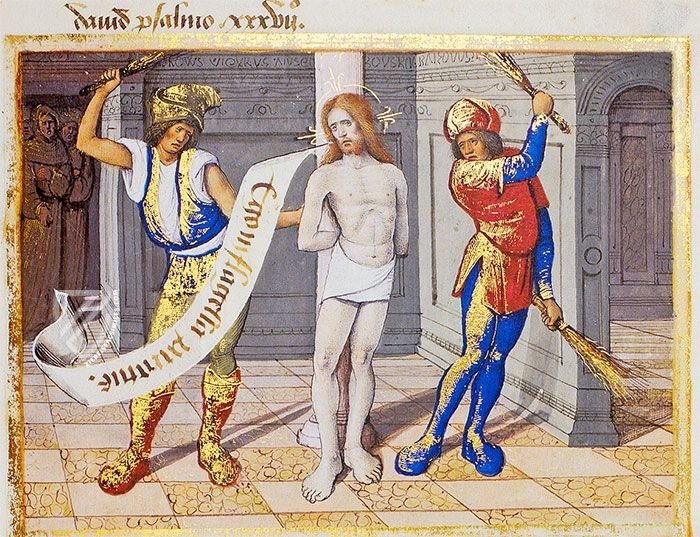
Sibylline Prophecies
The Persian Sibyl
Enthroned with a lantern in her hand and a snake are her feet, the Persian Sibyl’s prophecy reads: “See the animal you will trample. And the Lord of the Terrestrial Globe will be born. And the womb of a virgin will be the people’s salvation.” The Persian Sibyl is supposedly the author of the Sibylline Oracles and whose momentous prophecies include the coming of Alexander the Great.
This porcelain-skinned female figure is depicted in a Persian style hat and a cloth of gold dress trimmed with fur cuffs. Her throne is carved with various figures, as is the gilded architectural frame in which the scene is presented. Roman columns and windows in the background draw one’s eyes to an arid landscape with a castle perched atop a hill.
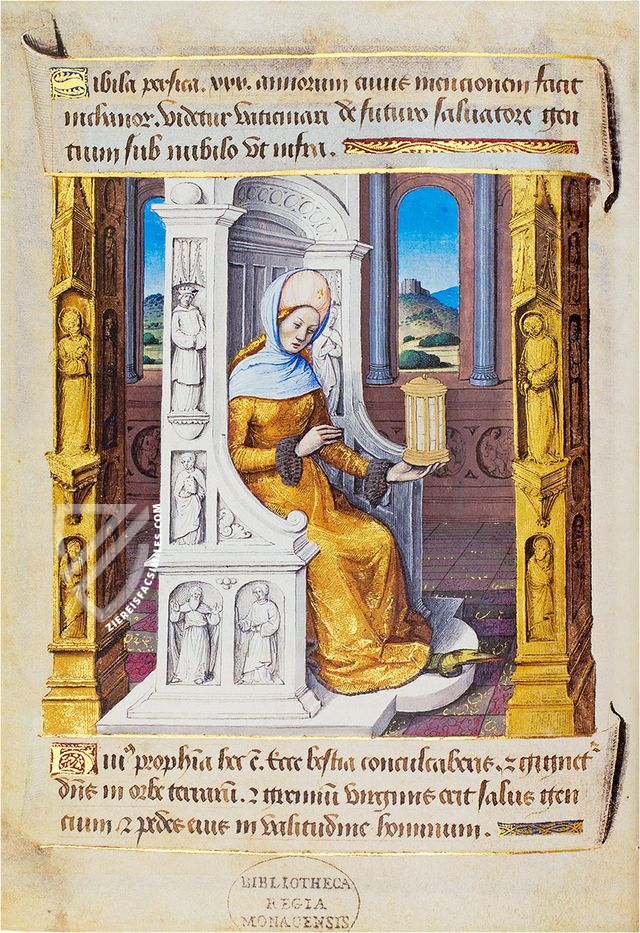
#1 Las Profecías de las Sibilas
Language: Spanish
(3,000€ - 7,000€)
- Treatises / Secular Books
- Apocalypses / Beatus
- Astronomy / Astrology
- Bestiaries
- Bibles / Gospels
- Chronicles / History / Law
- Geography / Maps
- Saints' Lives
- Islam / Oriental
- Judaism / Hebrew
- Single Leaf Collections
- Leonardo da Vinci
- Literature / Poetry
- Liturgical Manuscripts
- Medicine / Botany / Alchemy
- Music
- Mythology / Prophecies
- Psalters
- Other Religious Books
- Games / Hunting
- Private Devotion Books
- Other Genres
- Afghanistan
- Armenia
- Austria
- Belgium
- Belize
- Bosnia and Herzegovina
- China
- Colombia
- Costa Rica
- Croatia
- Cyprus
- Czech Republic
- Denmark
- Egypt
- El Salvador
- Ethiopia
- France
- Germany
- Greece
- Guatemala
- Honduras
- Hungary
- India
- Iran
- Iraq
- Israel
- Italy
- Japan
- Jordan
- Kazakhstan
- Kyrgyzstan
- Lebanon
- Liechtenstein
- Luxembourg
- Mexico
- Morocco
- Netherlands
- Palestine
- Panama
- Peru
- Poland
- Portugal
- Romania
- Russia
- Serbia
- Spain
- Sri Lanka
- Sweden
- Switzerland
- Syria
- Tajikistan
- Turkey
- Turkmenistan
- Ukraine
- United Kingdom
- United States
- Uzbekistan
- Vatican City
- A. Oosthoek, van Holkema & Warendorf
- Aboca Museum
- Ajuntament de Valencia
- Akademie Verlag
- Akademische Druck- u. Verlagsanstalt (ADEVA)
- Aldo Ausilio Editore - Bottega d’Erasmo
- Alecto Historical Editions
- Alkuin Verlag
- Almqvist & Wiksell
- Amilcare Pizzi
- Andreas & Andreas Verlagsbuchhandlung
- Archa 90
- Archiv Verlag
- Archivi Edizioni
- Arnold Verlag
- ARS
- Ars Magna
- ArtCodex
- AyN Ediciones
- Azimuth Editions
- Badenia Verlag
- Bärenreiter-Verlag
- Belser Verlag
- Belser Verlag / WK Wertkontor
- Benziger Verlag
- Bernardinum Wydawnictwo
- BiblioGemma
- Biblioteca Apostolica Vaticana (Vaticanstadt, Vaticanstadt)
- Bibliotheca Palatina Faksimile Verlag
- Bibliotheca Rara
- Boydell & Brewer
- Bramante Edizioni
- Bredius Genootschap
- Brepols Publishers
- British Library
- C. Weckesser
- Caixa Catalunya
- Canesi
- CAPSA, Ars Scriptoria
- Caratzas Brothers, Publishers
- Carus Verlag
- Casamassima Libri
- Centrum Cartographie Verlag GmbH
- Chavane Verlag
- Christian Brandstätter Verlag
- Circulo Cientifico
- Club Bibliófilo Versol
- Club du Livre
- CM Editores
- Collegium Graphicum
- Collezione Apocrifa Da Vinci
- Comissão Nacional para as Comemorações dos Descobrimentos Portugueses
- Coron Verlag
- Corvina
- CTHS
- D. S. Brewer
- Damon
- De Agostini/UTET
- De Nederlandsche Boekhandel
- De Schutter
- Deuschle & Stemmle
- Deutscher Verlag für Kunstwissenschaft
- DIAMM
- Droz
- E. Schreiber Graphische Kunstanstalten
- Ediciones Boreal
- Ediciones Grial
- Ediclube
- Edições Inapa
- Edilan
- Editalia
- Edition Deuschle
- Edition Georg Popp
- Edition Leipzig
- Edition Libri Illustri
- Editiones Reales Sitios S. L.
- Éditions de l'Oiseau Lyre
- Editions Medicina Rara
- Editorial Casariego
- Editorial Mintzoa
- Editrice Antenore
- Editrice Velar
- Edizioni Edison
- Egeria, S.L.
- Eikon Editores
- Electa
- Emery Walker Limited
- Enciclopèdia Catalana
- Eos-Verlag
- Ephesus Publishing
- Ernst Battenberg
- Eugrammia Press
- Extraordinary Editions
- Fackelverlag
- Facsimila Art & Edition
- Facsimile Editions Ltd.
- Facsimilia Art & Edition Ebert KG
- Faksimile Verlag
- Feuermann Verlag
- Folger Shakespeare Library
- Franco Cosimo Panini Editore
- Friedrich Wittig Verlag
- Fundación Hullera Vasco-Leonesa
- G. Braziller
- Gabriele Mazzotta Editore
- Gebr. Mann Verlag
- Gesellschaft für graphische Industrie
- Getty Research Institute
- Giovanni Domenico de Rossi
- Giunti Editore
- Graffiti
- Grafica European Center of Fine Arts
- Guido Pressler
- Guillermo Blazquez
- Gustav Kiepenheuer
- H. N. Abrams
- Harrassowitz
- Harvard University Press
- Helikon
- Hendrickson Publishers
- Henning Oppermann
- Herder Verlag
- Hes & De Graaf Publishers
- Hoepli
- Holbein-Verlag
- Houghton Library
- Hugo Schmidt Verlag
- Idion Verlag
- Il Bulino, edizioni d'arte
- ILte
- Imago
- Insel Verlag
- Insel-Verlag Anton Kippenberger
- Instituto de Estudios Altoaragoneses
- Instituto Nacional de Antropología e Historia
- Introligatornia Budnik Jerzy
- Istituto dell'Enciclopedia Italiana - Treccani
- Istituto Ellenico di Studi Bizantini e Postbizantini
- Istituto Geografico De Agostini
- Istituto Poligrafico e Zecca dello Stato
- Italarte Art Establishments
- Jan Thorbecke Verlag
- Johnson Reprint Corporation
- Josef Stocker
- Josef Stocker-Schmid
- Jugoslavija
- Karl W. Hiersemann
- Kasper Straube
- Kaydeda Ediciones
- Kindler Verlag / Coron Verlag
- Kodansha International Ltd.
- Konrad Kölbl Verlag
- Kurt Wolff Verlag
- La Liberia dello Stato
- La Linea Editrice
- La Meta Editore
- Lambert Schneider
- Landeskreditbank Baden-Württemberg
- Leo S. Olschki
- Les Incunables
- Liber Artis
- Library of Congress
- Libreria Musicale Italiana
- Lichtdruck
- Lito Immagine Editore
- Lumen Artis
- Lund Humphries
- M. Moleiro Editor
- Maison des Sciences de l'homme et de la société de Poitiers
- Manuscriptum
- Martinus Nijhoff
- Maruzen-Yushodo Co. Ltd.
- MASA
- Massada Publishers
- McGraw-Hill
- Metropolitan Museum of Art
- Militos
- Millennium Liber
- Müller & Schindler
- Nahar - Stavit
- Nahar and Steimatzky
- National Library of Wales
- Neri Pozza
- Nova Charta
- Oceanum Verlag
- Odeon
- Orbis Mediaevalis
- Orbis Pictus
- Österreichische Staatsdruckerei
- Oxford University Press
- Pageant Books
- Parzellers Buchverlag
- Patrimonio Ediciones
- Pattloch Verlag
- PIAF
- Pieper Verlag
- Plon-Nourrit et cie
- Poligrafiche Bolis
- Presses Universitaires de Strasbourg
- Prestel Verlag
- Princeton University Press
- Prisma Verlag
- Priuli & Verlucca, editori
- Pro Sport Verlag
- Propyläen Verlag
- Pytheas Books
- Quaternio Verlag Luzern
- Reales Sitios
- Recht-Verlag
- Reichert Verlag
- Reichsdruckerei
- Reprint Verlag
- Riehn & Reusch
- Roberto Vattori Editore
- Rosenkilde and Bagger
- Roxburghe Club
- Salerno Editrice
- Saltellus Press
- Sandoz
- Sarajevo Svjetlost
- Schöck ArtPrint Kft.
- Schulsinger Brothers
- Scolar Press
- Scrinium
- Scripta Maneant
- Scriptorium
- Shazar
- Siloé, arte y bibliofilia
- SISMEL - Edizioni del Galluzzo
- Sociedad Mexicana de Antropología
- Société des Bibliophiles & Iconophiles de Belgique
- Soncin Publishing
- Sorli Ediciones
- Stainer and Bell
- Studer
- Styria Verlag
- Sumptibus Pragopress
- Szegedi Tudomànyegyetem
- Taberna Libraria
- Tarshish Books
- Taschen
- Tempus Libri
- Testimonio Compañía Editorial
- Thames and Hudson
- The Clear Vue Publishing Partnership Limited
- The Facsimile Codex
- The Folio Society
- The Marquess of Normanby
- The Richard III and Yorkist History Trust
- Tip.Le.Co
- TouchArt
- TREC Publishing House
- TRI Publishing Co.
- Trident Editore
- Tuliba Collection
- Typis Regiae Officinae Polygraphicae
- Union Verlag Berlin
- Universidad de Granada
- University of California Press
- University of Chicago Press
- Urs Graf
- Vallecchi
- Van Wijnen
- VCH, Acta Humaniora
- VDI Verlag
- VEB Deutscher Verlag für Musik
- Verlag Anton Pustet / Andreas Verlag
- Verlag Bibliophile Drucke Josef Stocker
- Verlag der Münchner Drucke
- Verlag für Regionalgeschichte
- Verlag Styria
- Vicent Garcia Editores
- W. Turnowski Ltd.
- W. Turnowsky
- Waanders Printers
- Wiener Mechitharisten-Congregation (Wien, Österreich)
- Wissenschaftliche Buchgesellschaft
- Wissenschaftliche Verlagsgesellschaft
- Wydawnictwo Dolnoslaskie
- Xuntanza Editorial
- Zakład Narodowy
- Zollikofer AG

